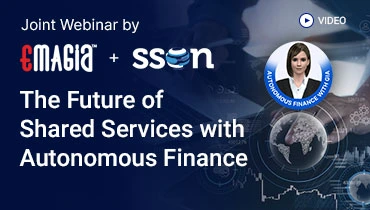In the relentless pursuit of efficiency, scalability, and strategic value, the world of finance is undergoing a seismic shift. For shared service centers (SSCs), which form the operational backbone of many global enterprises, this transformation is not just an opportunity—it’s an imperative. The era of simple automation is evolving into something far more powerful: autonomous finance. This is not merely about doing things faster; it’s about creating intelligent, self-learning financial ecosystems that drive predictive insights and strategic decision-making.
Traditional shared services have long grappled with challenges like high volumes of manual transaction processing, the risk of human error, and the constant pressure to reduce costs. While robotic process automation (RPA) offered a first wave of relief, it was only the beginning. The future lies in autonomous finance, a state where complex financial processes manage themselves, learning and adapting with minimal human intervention. This guide will explore the profound impact of autonomous finance on shared services, from its core components to a practical roadmap for implementation.
From Automation to Autonomy: The Evolution of Finance in Shared Services
It’s crucial to distinguish between automation and autonomy. Automation, in its basic form, involves programming a machine to perform a repetitive, rules-based task. Think of it as creating a digital assistant that follows a strict set of instructions. This has been the domain of RPA in finance for years, tackling tasks like data entry and basic reconciliations.
Autonomous finance, however, is a significant leap forward. It integrates advanced technologies like artificial intelligence (AI), machine learning (ML), and natural language processing (NLP). Instead of just following pre-programmed rules, an autonomous system can analyze vast datasets, recognize patterns, make judgments, and learn from outcomes. It’s the difference between a system that can process an invoice and one that can identify a fraudulent invoice, predict a customer’s likelihood of late payment, and suggest optimal payment terms—all on its own.
The Cornerstones of Autonomous Finance for Shared Services
The power of autonomous finance is built on a foundation of interconnected technologies, each playing a vital role in creating a self-sufficient financial ecosystem within a shared service center.
Artificial Intelligence (AI) and Machine Learning (ML)
AI and ML are the brains of the autonomous finance operation. These technologies enable systems to move beyond simple task execution to predictive analysis and intelligent decision-making. In a shared services context, this means forecasting cash flow with greater accuracy, detecting anomalies that could indicate fraud, and providing data-driven insights to business leaders.
Robotic Process Automation (RPA)
RPA remains a workhorse in the autonomous finance landscape. It excels at handling the high-volume, repetitive tasks that are characteristic of shared service environments. By automating these manual processes, RPA frees up human talent to focus on more strategic, value-added activities that require critical thinking and complex problem-solving.
Natural Language Processing (NLP)
A significant portion of financial data is unstructured, locked away in documents like emails, contracts, and invoices. NLP gives autonomous systems the ability to understand and interpret human language, allowing them to extract critical information from these unstructured sources and integrate it into automated workflows.
Advanced Analytics and Data Visualization
To be truly autonomous, a system needs to provide clear, real-time insights into its operations and the financial health of the organization. Advanced analytics and data visualization tools translate complex data into intuitive dashboards and reports, enabling finance professionals to monitor performance, identify trends, and make informed strategic decisions at a glance.
The Transformative Benefits of Autonomous Finance for Shared Services
The adoption of autonomous finance within shared services is not just an IT upgrade; it’s a strategic business decision that delivers a multitude of compelling benefits.
Achieving True “Touchless” Processing
Imagine a world where invoices are received, validated, and paid without a single human touch. This is the promise of autonomous finance. In core shared services functions like procure-to-pay (P2P), order-to-cash (O2C), and record-to-report (R2R), autonomous systems can handle the end-to-end process, dramatically increasing speed and efficiency.
Significant Reduction in Operational Costs
By minimizing manual intervention and reducing the errors that lead to costly rework, autonomous finance directly impacts the bottom line. It allows shared service centers to handle a greater volume of transactions without a proportional increase in headcount, leading to significant cost savings and improved scalability.
Elevating the Strategic Role of Finance
When finance professionals are no longer mired in transactional tasks, they can evolve into strategic business partners. Autonomous systems provide the data and insights that empower them to focus on financial planning and analysis (FP&A), risk management, and providing strategic guidance to the wider organization.
Enhanced Accuracy, Compliance, and Speed
Autonomous systems operate 24/7 with a level of accuracy that is impossible to achieve through manual processes. They can perform real-time validations against a vast array of rules and regulations, ensuring compliance and significantly reducing the risk of financial penalties. Furthermore, the speed of automated processing accelerates critical financial cycles, such as the month-end close.
A Practical Roadmap for Implementing Autonomous Finance in Shared Service Centers
The journey to autonomous finance requires a thoughtful and strategic approach. Here is a step-by-step roadmap for shared service centers looking to embrace this transformative model.
Step 1: Assess and Standardize Your Processes
Begin by identifying the processes that are most ripe for automation—typically those that are high-volume, repetitive, and rules-based. It’s also critical to standardize these processes across the organization to ensure the smooth operation of autonomous systems.
Step 2: Build a Strong Data Foundation
The success of any AI-driven system hinges on the quality of the data it’s fed. Invest in data cleansing, governance, and management to ensure your data is accurate, consistent, and readily accessible.
Step 3: Select the Right Technology Partner
Look for technology partners that offer an integrated platform for autonomous finance rather than a collection of disparate point solutions. A unified platform will provide greater visibility, control, and efficiency.
Step 4: Start with a Pilot and Scale Incrementally
Don’t try to boil the ocean. Start with a pilot project focused on a specific, high-impact process. This will allow you to demonstrate the value of autonomous finance and build momentum for a broader rollout.
Step 5: Cultivate a Culture of Continuous Improvement
Autonomous finance is not a one-time project; it’s a new way of operating. Foster a culture that embraces change, encourages continuous learning, and focuses on upskilling your workforce to collaborate effectively with intelligent systems.
Unlocking Autonomous Potential: The Emagia Advantage for Shared Services
Navigating the path to autonomous finance requires a powerful and intelligent technology platform. This is where Emagia stands out as a leader in providing AI-powered solutions specifically designed for the complexities of modern finance and the unique needs of shared service centers. Emagia’s platform is engineered to transform traditional, labor-intensive financial processes into a streamlined, autonomous, and data-driven ecosystem.
For shared services grappling with order-to-cash challenges, Emagia’s AI-powered solutions for accounts receivable offer a transformative approach. Its autonomous cash application module uses machine learning to achieve unparalleled match rates, drastically reducing the manual effort required for reconciliation. Furthermore, its intelligent collections and deductions management capabilities leverage predictive analytics to prioritize collection activities and proactively resolve disputes, leading to a significant reduction in days sales outstanding (DSO) and an improvement in working capital. By integrating with existing ERP systems, Emagia provides a single source of truth, empowering shared services to deliver strategic value through enhanced efficiency and real-time financial intelligence.
Frequently Asked Questions about Autonomous Finance for Shared Services
What is autonomous finance?
Autonomous finance refers to the use of advanced technologies like artificial intelligence (AI), machine learning (ML), and robotic process automation (RPA) to create self-managing, self-learning, and self-correcting financial processes. The goal is to minimize human intervention in routine tasks, enabling finance professionals to focus on more strategic activities.
How is AI transforming finance shared services?
AI is transforming finance shared services by moving beyond simple task automation to intelligent process automation. AI-powered systems can analyze vast amounts of data, identify patterns and anomalies, make predictions, and support complex decision-making. This enhances efficiency, accuracy, and the strategic value of shared service centers.
What is the future of finance shared services?
The future of finance shared services is autonomous, data-driven, and strategically focused. SSCs will evolve from being transactional processing hubs to becoming centers of excellence that leverage technology to provide real-time insights, predictive analytics, and strategic guidance to the entire organization.
What are the main benefits of automation in shared services?
The main benefits of automation in shared services include significant cost reduction, increased efficiency and productivity, improved accuracy and compliance, enhanced data security, and the ability to scale operations without a proportional increase in headcount. It also frees up employees to focus on higher-value work.
Will autonomous finance replace jobs in shared services?
While autonomous finance will automate many of the repetitive, transactional tasks currently performed by humans, it is more likely to transform jobs rather than eliminate them entirely. The focus will shift from data entry and manual processing to data analysis, strategic thinking, and managing the autonomous systems themselves. This will require an upskilling of the workforce to embrace these new roles.



